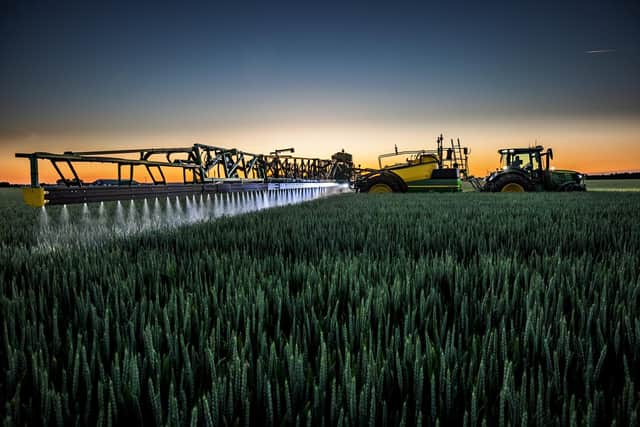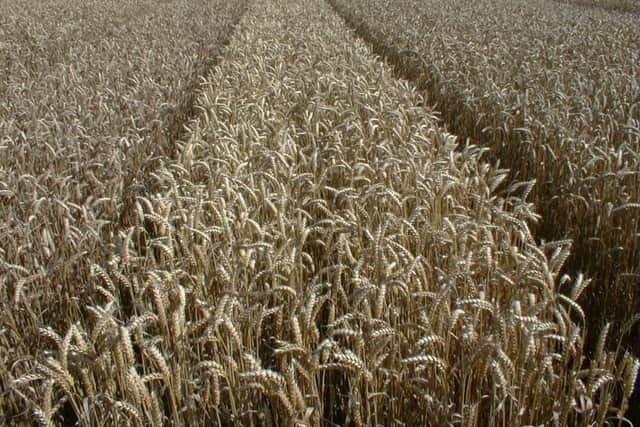Fungicide use options for 2023
and live on Freeview channel 276
Crop yields were well up, the quality of straw was excellent, prices were good and getting on with field work was an absolute joy.
But can the same be repeated in 2023? The initial indications are that autumn sown cereals have wintered well.
Advertisement
Advertisement
But as 2023 progresses, the arable sector is having to face up to a number of headwinds.


These include the still expensive cost of fertiliser and, perhaps more importantly, the fast rising costs of plant protection products.
On the plus side, the continuing availability of the DAERA grant on protein crops will help to further boost the growing of protein crops in Northern Ireland.
There is also a growing recognition that we need to grow more grain in Northern Ireland across the board.
Advertisement
Advertisement
Such a development will help lower the carbon footprint of agriculture as a whole.


And making us less reliant on imported grain is an inherently strong principle to act upon.
Recent years have seen a growing focus on growing crops with a lesser reliance on pesticides: herbicides and fungicides.
A commitment to crop development strategies using a so-called integrated pest management (IPM) approach is now very much in vogue.
Advertisement
Advertisement
However, the effective use of fungicides is still regarded as being of fundamental importance in this context.
The future use options for these specific plant protectant products in cereal crops was discussed in detail at a recent workshop held in Co. Down.
The event was hosted by the College of Agriculture, Food and Rural Enterprise (CAFRE).
Both the main speakers in attendance discussed a fast-changing landscape, where the future use of these chemistries is concerned.
Advertisement
Advertisement
The key driver, in this context, will be the combined use of variety-based and agronomic management tools, in tandem with the most effective application of chemicals.
“We must not lose the products that are available to us now,” stressed Teagasc’s Dr Steven Kildea.
“The pipeline of new formulation chemistries has, more or less come to an end.” Septoria is the main threat for winter wheat crops growing in Ireland. According to Kildea, planting later in the autumn is one way of reducing the disease risk that wheat crops are exposed to.
He added:“It takes Septorai spores quite a while to manifest themselves as a physical disease outbreak. So if planting is delayed, the disease risk is proportionately reduced.
Advertisement
Advertisement
“Planting wheat directly after the combine represents the worst of all worlds. Both stubble and straw represent very significant sources of septoria spores.
“But everything comes down to balance: the weather can break later in the autumn, as was the case last year.
“Effective planting decisions can only be taken by farmers who know their fields best.”
Kildea pointed out that making effective use of fungicides has two dimensions: actual disease control and the monies involved.
Advertisement
Advertisement
“In many ways, both issues are inter-linked. Where septoria is concerned, I would not be at all worried if the disease was found in a crop at this time of the year.
“The real challenge is to ensure that the first, second and third leaves are maintained in a disease free state while the grains are filling in the ears.”
Using this premise, the Oakpark-based research scientist proffered a two spray fungicide programme, in order to control septoria within winter wheat crops.
He explained:“The application of a fungicide when the third leaf is fully emerged also gives a level of protection to second leaf, which will be in the process of unfurling at that stage in the development of the plant.
Advertisement
Advertisement
“The follow-up spray should be applied to protect the flag leaf. This approach maximises the efficiency of the fungicides used while also minimising the cost incurred by the grower.”
Kildea added:“Fuingicides should not be applied to crops at times when plants are under stress.
KIldea pointed to the breeding of wheat varieties with inherently greater resistance to disease.
He added:“However, this process came off the tracks to a large extent with the development of varieties with a Cougar heritage.
Advertisement
Advertisement
“We saw a breakdown in the variety’s resistance to evolving septoria populations. However, by that stage Cougar had already been used in a number of varietal development projects.”
Agriculture and Horticultural Development Board agronomist Michelle Nuttall also confirmed the need for growers to look at both variety-related and agronomic factors when it comes to growing wheat.
“Planting later in the season and selecting varieties with a higher score for disease resistance are now critically important factors when it comes to growing profitable crops of wheat.”
According to Nuttall, the use of wheat blends within a crop brings together the disease-resistance profiles of several cereal varieties.
Advertisement
Advertisement
The approach has potential to reduce disease, improve stability and increase yield. Blends, therefore, could potentially reduce risk for levy payers. While research has shown that fungicide inputs can be reduced in mixtures, it’s not yet conclusive.
AHDB is currently offering a ‘blend tool’, which allows growers to mix either three of four different varieties in a seed mix. The organisations varietal selection tool, which features on its website, has a filtering mechanism
This provides growers with a simple way of excluding varieties from an analysis.
In other words, the tool allows for the selection of specify market requirements, accounting for key diseases and reflecting preferred agronomic features.
Advertisement
Advertisement
Nuttall drew specific attention to the Least Significant Difference (LSD) values contained within AHDB’s recommended list tables.
Natural variability, within and between trials, means that differences may occur due to chance, rather than an actual (repeatable) effect.
For most numerical characteristics in the tables, an average of least significant difference (LSD) is reported.
Differences between variety means those that are larger than the LSD are likely to reflect genuine differences, as they would only occur by chance fewer than 1 in 20 times (5%).
Advertisement
Advertisement
Differences smaller than the LSD are more likely to occur by chance and should be treated with caution.
She specifically questioned the use of fungicides when growing wheat varieties that have inherently high levels of disease resistance.
Nuttall continued:“In some cases the yield response achieved may not be large enough to justify the initial investment in the fungicide.
“In 2022, the average cost of applying fungicides to winter wheat crops in the UK was £102/ac.
Advertisement
Advertisement
“So, at the end of the day, this is all about growers being able to make money.”
Nuttall reviewed the results of the 2022 AHDB fungicide trials on wheat. The disease targets here are: brown rust, fusarium, septoria and yellow rust.
The trial sites used by AHDB are located in areas where disease pressure is known to be high. Additional trials are conducted and funded in Ireland by Teagasc.
Targeting of individual diseases is further enhanced by using crop varieties with high susceptibility to the target disease but good resistance to other diseases. Where possible, current recommended list varieties are used.
Advertisement
Advertisement
All diseases present are assessed, along with green leaf area (GLA) in cereals. Additional assessments of stem base diseases, lodging and ear diseases are made to provide context to the target disease results.
All trials, except wheat head blight trials, are harvested for yield.
According to the AHDB representative, mixtures and alternations of fungicides with different modes of action, from different fungicide groups, are often most effective and reduce the likelihood that fungicide resistance will develop in pathogens.
The 2022 AHDB fungicide trials on wheat confirmed a number of general trends.
Advertisement
Advertisement
On septoria, mefentrifluconazole and fenpicoxamid are leading actives. Mixtures containing these actives give highest levels of activity.
On yellow rust, Elatus Era was particularly effective but all mixtures performed well. Mefentrifluconazole and SDHIs tested were highly active on brown rust: fenpicoxamid and prothioconazole showed useful activity.
Where septoria sensitivity is concerned, the 2022 AHDB monitoring data shows no significant shifts, and all isolates tested were within previous ranges.
Turning to barley, Steven Kildea confirmed that ramularia is a great ‘yield robber’ under Irish conditions.
Advertisement
Advertisement
He said that breeding programmes for barley had been successful in developing varieties that are inherently more resistant to disease.
“We have not seen the breakdown in disease resistance in new barley varieties, as has been the case with wheat,” he explained.
According to Kildea, grain numbers dictate the overall yield potential of barley crop. This is why the number of stems within a crop is so important.
“Grain fill can only be taken to a certain stage within a barley crops. This is not the case with wheat, where grain fill can develop and can continue for a considerably longer period of time,” he explained.
Advertisement
Advertisement
“Ramularia must be tackled early in the season. The other diseases of note that can attack barley crops are net blotch and rhyncosporium.”
Where ramularia control in spring barley is concerned, Teagasc is currently recommending the first application of a fungicide at growth stage 31/32 to deliver protection for the lower leaves.
This should be followed up with another application between growth stages 45 and 49, in order to protect the upper canopy.
Following the loss of the loss of chlorothalonil, Teagasc conducted a ramularia trial on spring barley crops between 2019 and 2022. All the products used were applied at the awns emerging stage. The recommended rate for each product was used.
The key parameters assessed were:
Actual disease control achieved and final yields.
Advertisement
Advertisement
The final results of the work confirm that Folpet, when applied at a rate of 500g/ha, works well within a spring barley scenario.
Michelle Nuttall reviewed the results of the 2022 AHDB fungicide trials on barley.
The work confirmed that prothioconazole, fluxapyroxad and mefentrifluconazole gave effective rhynchosporium control, particularly when used in a protectant situation
A mix of actives (as in Ascra Xpro and Revystar XE) was more effective than straight products and is also an effective anti-resistance strategy.
Advertisement
Advertisement
Prothioconazole and mefentrifluconazole gave reductions in ramularia.
Fluxapyroxad was less effective than the azoles tested.
Brown rust was well controlled by all fungicides tested. For mildew, SDHIs, fluopyram, and bixafen add useful protectant activity (in Ascra Xpro). Good control also from Revystar XE.
For net blotch, azoles add useful activity to SDHIs.
Steven Kildea highlighted the value of Teagasc’s winter wheat and spring barley guides.
The content of both publications is based on detailed monitoring of crops to understand better how yield is formed.
Advertisement
Advertisement
They bring together a large body of Teagasc crop production research, carried out over recent years.
Work on the development of Teagasc oat guide is ongoing.
“New fungicide chemistries have brought us back in terms of disease control to where we were when the SDHI azoles were first brought to market,” Kildea added.
“Going forward, these new products must be managed properly so that we prevent resistance becoming an issue or, at the very least, we delay the onset of resistance.”